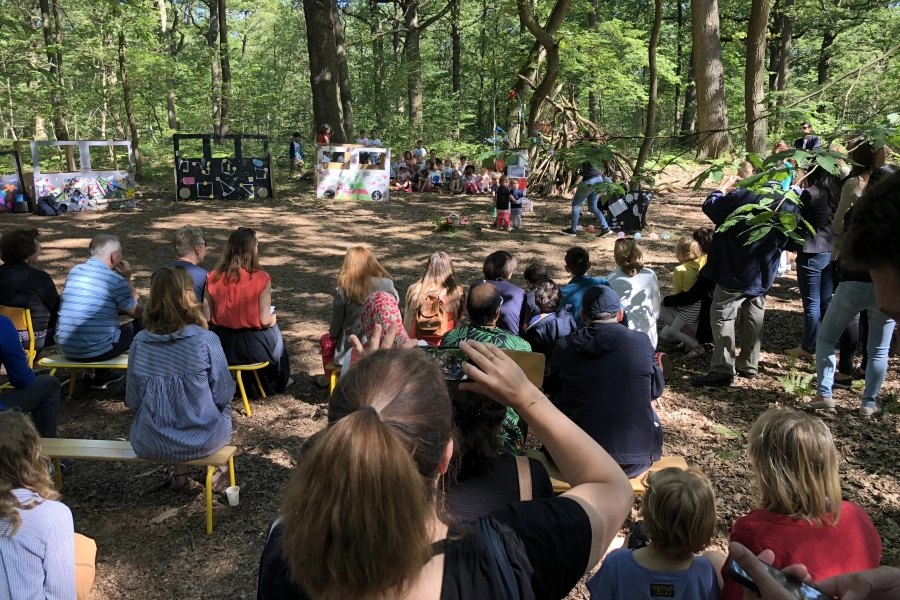


How Forest brings education to the environment and sustainable development
A Forest School is an outdoor education setting in which students can freely study in a natural environment. This immersion in nature has been a practice in many kindergartens in Scandinavian countries for over 40 years.
At the Forest International School Paris, for example, this concept of immersion in nature has become an integral part of the whole school curriculum.
This approach to learning is increasingly popular due to an awareness of a “Nature Deficit Disorder”, also known as the lack of nature syndrome, exacerbated by sedentary lifestyles, urbanization, and a lack of time spent outdoors, all of which contribute to health issues and problems.
Pedagogy:
Nature obviously plays a central role in this form of education. It is an ideal playground and learning environment for children. Various studies on this approach to learning have demonstrated the benefits of these practices on the development of creativity, sociability, autonomy, and the overall well-being of the child. In practice, classes are conducted in a forest, park or garden, etc. every day. There is no charter or theoretical formalization of the concept of an ecological school, so each institution can adapt and integrate it into its own way of doing things. Thus, sometimes, learning will be more informal, while in others, it will be more structured.
Education on environmental issues and sustainable development has become a significant concern in schools worldwide. This article will explore how a bilingual school can incorporate these vital concepts into its educational program. By combining language learning with environmental awareness, bilingual schools can play a crucial role in shaping responsible and environmentally conscious individuals.
Integration of Environmental Concepts in the School Curriculum:
To effectively teach environmental education and sustainable development, bilingual schools must integrate these concepts into their curriculum from an early age. This can be achieved through dedicated courses, interdisciplinary activities, and practical projects that raise students' awareness of local and global environmental issues.
Utilization of Languages in Environmental Education:
The advantage of bilingual schools lies in their ability to teach these concepts using multiple languages. By teaching both natural sciences and languages in a bilingual context, students are exposed to a variety of perspectives and knowledge, enriching their understanding of the environment and enhancing their language skills.
Implementation of Sustainable Practices in School Operations: To align with the principles of environmental education, bilingual schools must also adopt sustainable practices in their daily operations. This may include initiatives such as waste reduction, the use of renewable energy sources, promoting carpooling, and integrating school gardens to educate students about the importance of sustainable agriculture.
Field Trips and Community Projects:
Field trips and community projects play a vital role in environmental education. Bilingual schools can organize excursions to local natural areas, visits to organic farms, or collaborations with environmental organizations to allow students to directly experience biodiversity and sustainable practices in action.
International Collaboration and Cultural Exchanges:
As bilingual schools, these institutions also have the opportunity to promote international collaboration and cultural exchanges in environmental education. Partnerships with schools in other countries enable students to share their experiences and knowledge about global environmental issues while developing their intercultural sensitivity.
The benefits of Forest School are numerous and varied:
- Nature connection: Forest School provides children with a valuable opportunity to connect with nature in a direct and profound way. By spending time outdoors in natural environments such as forests, woodlands, or parks, children develop an emotional bond with nature and learn to appreciate and respect their environment.
- Development of practical skills: Activities practiced during outdoor sessions encourage the development of practical skills such as construction, navigation, plant and animal recognition, and problem-solving. These skills are essential for daily life and can boost children's self-confidence.
- Stimulates creativity: Nature provides an environment rich in sensory stimuli and exploration opportunities. This stimulates children's creativity, prompting them to invent games, stories, and activities using the natural resources around them.
- Experiential learning: Forest School emphasizes learning through experience. Children are encouraged to explore, experiment, and discover for themselves, which promotes a deeper understanding of natural concepts and phenomena.
- Promotion of health and well-being: Spending time outdoors in a natural environment contributes to promoting children's health and well-being. Exposure to sunlight, fresh air, and physical activity promotes physical and mental health, reducing stress and boosting morale.
- Strengthens social bonds: Forest School provides children with the opportunity to develop strong social relationships with their peers and educators. Working and playing together in a natural setting encourages teamwork, cooperation, and mutual respect.
Conclusion
Outdoor learning and sustainable development in a bilingual school offer numerous opportunities to raise students' awareness of environmental issues while enhancing their language skills and intercultural understanding. By integrating these concepts into the curriculum, adopting sustainable practices, and promoting international collaboration, bilingual schools can play a crucial role in shaping responsible and environmentally conscious citizens for future generations.


